The Cast Iron Plant the common name for Aspidistra elatior. The Aspidistra is an old-fashioned, tough, leathery foliage house plant. It is an ideal indoor plant for cooler areas of your house bringing the tropics indoors.
Cast-Iron plants were a favorite indoor plant along with the Howea Kentia palm during the Victorian era when houses were anything but bright and airy.
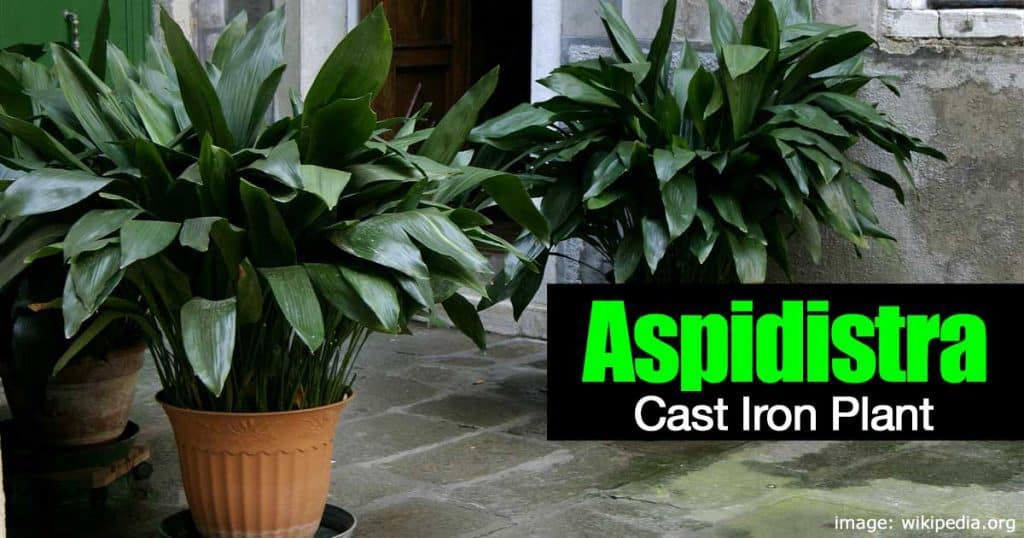 Potted Aspidistra elatior with dark green foliage is a hardy plant. Used as a ground cover in the southern US. Does best when plants are not exposed to direct sunlight.
Potted Aspidistra elatior with dark green foliage is a hardy plant. Used as a ground cover in the southern US. Does best when plants are not exposed to direct sunlight.
This plant with dark green leaves was used to decorate long before we heard of or discussed peace lily care, Aglaonema varieties, or using the Snake plant as houseplants.
Today, in the Southern United States like Louisiana, you find the cast iron plant growing as a carefree ground cover in dense, deep shade.
The Aspidistra genus (Asparagaceae) is made of up about 100 species with over 60 originating in China. Kew Gardens list 1823, as the year of the first recorded Aspidistra but the genus was named Aspidistra by John Ker Gawler in 1822.
The most popular species is Aspidistra elatior, native to the Eastern Himalayas, Taiwan, China, and Japan, and the plant we call the “cast iron plant” or “iron plant”.
The cast iron plant is one of the few plants we can say helped inspire or carry the lead in a novel.
In 1936, George Orwell wrote his novel “Keep the Aspidistra Flying.”
 Keep the Aspidistra Flying by George Orwell. Penguin Edition, 1962.
Keep the Aspidistra Flying by George Orwell. Penguin Edition, 1962.
First published in 1936. – via Gwydion M. Williams
In World War II, “Winston Churchill authorized the purchase of a very powerful radio transmitter from the United States under the codename “Aspidistra” borrowed from the popular song ‘The Biggest Aspidistra in the World’.” [source]
Owners of small cast iron plants need patience. It takes considerable time to grow an Aspidistra to specimen size.
Like many “folk” plants, it is not always available in nurseries. This is partly because of its slow growth and not properly appreciated.
Cast iron plants are usually grown in 6″, 8″; and 10″ inch azalea pots. As a bushy potted plant, 12″ to 24″ inches tall and wide, the Aspidistra has few equals. It makes a perfect plants for indoor use like in a bathroom.
Aspidistra is an ideal plant for that cooler area of your house to bring the tropics indoors.
Aspidistra Will Also…
- Tolerate dust as well as heat, cold, wet soil, drought tolerant, neglect and areas with low lighting.
- Tolerate temperatures as low as 28° degrees Fahrenheit without injury to the foliage. (more on cold tolerant houseplants)
- Tolerate light levels as low as 10 foot candles
- Make a great addition to cut flower arrangements; the foliage often lasts for weeks.
- Generally Pest Free
Aspidistra elatior has cornlike, shiny, dark green leaves with blades growing to 24″ inches long. On occasion, Apsidistra produces purple-brown small flowers near the base of the plant.
It also has a variegated form like the image below. The white markings help to light up a dark corner rather like the sun filtering through a shade tree.
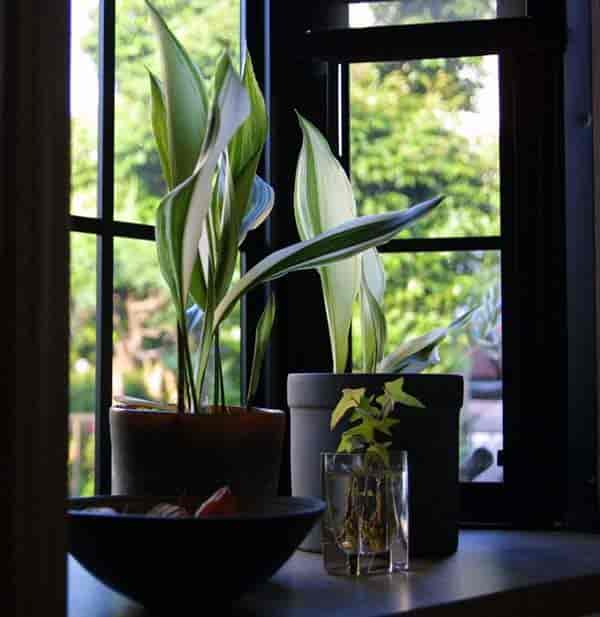 A dwarf form called Aspidistra minor or Aspidistra Milky Way has black-green leaves with white-spots. Try to collect all three and display them in attractive decorative containers.
A dwarf form called Aspidistra minor or Aspidistra Milky Way has black-green leaves with white-spots. Try to collect all three and display them in attractive decorative containers.
Aspidistra is a slow grower, is expensive to produce and cost more. But, with all its positive attributes, it is well worth the price. Aspidistras offer long-term enjoyment and beauty.
Unusual Aspidistra Cast Iron Flower
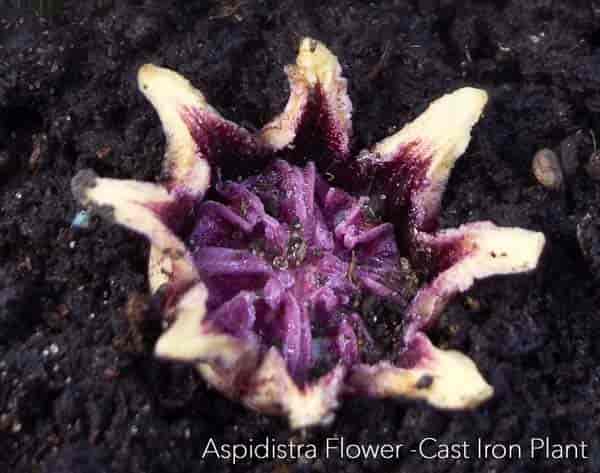 Bell-shaped flower of the cast iron plant – Aspidistra elatior via Stewart Black / Flickr
Bell-shaped flower of the cast iron plant – Aspidistra elatior via Stewart Black / Flickr
Aspidistra elatior was popular as a foliage plant in Victorian times. They survived under adverse conditions with a remarkable ability to withstand abuse and neglect.
It’s been said, “the Aspidistra was immune to the effects of gas used for lighting in the Victorian era (other plants and flowers withered or yellowed), which might account for its popularity.” [source]
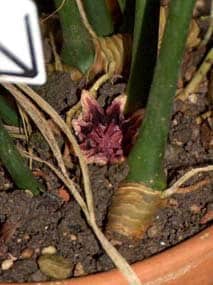 Today, these same tough and resilient characteristics allow them to endure indoor conditions of today’s modern homes and offices. The aspidistra leaf is evergreen all year. But, this ovate glossy-leaved plant does bear flowers and fruits just beneath the soil line.
Today, these same tough and resilient characteristics allow them to endure indoor conditions of today’s modern homes and offices. The aspidistra leaf is evergreen all year. But, this ovate glossy-leaved plant does bear flowers and fruits just beneath the soil line.
Video: Aspidistra Care Instructions
In this video, Kevin talks about caring for variegated cast iron plants – watering, lighting, fertilizing and grooming.
Cast Iron Plant Care And Cultural Tips:
The name Cast Iron comes from its ability to tolerate poor conditions both inside or out. It is easy to grow and requires little care.
Indoors, Aglaonemas, the durable “Zanzibar Gem” (ZZ plant), and snake plants are possibly the only other indoor plants capable of handling these conditions. Low light, drafts and general neglect in watering and dust accumulation.
But, you can find many types of indoor houseplants to fit your conditions and environment.
 The Aspidistra plant has long, dark green 15″ – 30” inch leaves, 3″ – 4” inches wide producing an arching effect reaching a height of 3′ feet tall.
The Aspidistra plant has long, dark green 15″ – 30” inch leaves, 3″ – 4” inches wide producing an arching effect reaching a height of 3′ feet tall.
The dark green leaves grow upward in clusters from thick, fleshy root stalks and stems at the base.
The small globular aspidistra flowers with a violet-brown color (in a perianth) grow at soil level.
Lighting and Temperature
It is much more attractive with proper care and will tolerate a wide range of temperatures.
It prefers temperatures between 50°-55° degrees Fahrenheit at night and 70°-75° degrees Fahrenheit during the day with light levels between 50 and 500-foot candles.
In The Landscape: It is recommended for USDA Hardiness Zones 7 through 11. Does best when shaded from direct sun. The cast iron plant handles temperature extremes from 45° to 85° degrees Fahrenheit very well, and temperatures do not seem to affect plant growth.
As a House Plant: Bright light from a north window is best. If growing under artificial light, the plant will do well with 150-foot candles.
Soil and Potting Medium
In The Landscape: Outside, plant Aspidistra in a good quality well-drained garden soil with decayed manure and up to 1/3 part peat or humus added.
NOTE: I have personally seen beds of cast iron plants do very well in poor soil.
 Cast iron Aspidistra plants growing as a ground cover in a landscape bed – Disney World, Animal Kingdom 2018
Cast iron Aspidistra plants growing as a ground cover in a landscape bed – Disney World, Animal Kingdom 2018
As a Potted Plant use a good quality well-drained soil mix like those made for African Violets. Make your own potting soil with one part all-purpose loam, one part peat moss, one part perlite or vermiculite.
The plant does well when pot-bound and needs repotting every two to three years. Repot in early spring before new growth begins.
Watering
Do not allow the root system to stay wet and soggy. But, keep the soil moist at all times.
Evenly moist but not constantly wet is the ideal way to water this plant, although it will survive forgotten waterings. Aspidistra does handle dry air and low humidity but does best with some air moisture.
Fertilizer
As a slow grower, do not over feed. At high light levels fertilizing once per month at 1/2 strength with a liquid food. Or apply a balanced slow-release fertilizer in the spring before growth begins.
Under low light conditions, liquid feed every 3 to 4 months.
Stop feeding during the cold winter months.
Propagation
Propagate a new plant by root division. When dividing, cut each division into two to three leaves. Make new plants by planting multiple divisions together in a large growing pot.
Pest, Disease and Physical Issues
Check out these posts for:
- Scale bugs on plants
- Natural ways to get rid of spider mites
Cracked leaves from bruising: Usually caused by people brushing up against the plant. Move the plant to a new location where will not run into it.
Yellowing of leaves: Usually caused by exposure to strong lighting.
Move this deep shade loving plant to a location where it will receive filtered shade. Do not allow plants to sit in direct sun.
White variegation turns to solid green. Loss of variegation happens when:
- Soil is too rich – stop feeding especially during winter
- Soil does not properly drain – make sure water does not sit in the bottom of the pot, and the drainage holes are not covered.
- The plant receives too little light – This deep shade lover does not like darkness. Move the plant to a brighter location or closer to an artificial light source.
Leaves become damp and blistered with yellow, white, black or brown spots. This condition comes from a bacterial or fungal disease commonly called leaf-spot disease. The cause is poor air circulation, overwatering, high humidity, low light or chilling.
In very severe cases the cast iron will lose all foliage. Increase ventilation, light, and temperature to help dry out the soil. Remove infected areas, spray with an approved broadband fungicide, and DO NOT water. Resume regular care after the plant recovers.
Origin: Distribution China and Southern Japan
Family: Asparagaceae
The Family Of Aspidistra Species Grows
The genus has been ignored until about the 1980’s. Since then many new Aspidistra plant species have been recognized.
In March 2005, during a field trip to Shiwandashan Mountains in southern Guangxi Zhuang Autonomous Region, China, the second author (Yan Liu) collected and brought back a sterile plant of Aspidistra for cultivation, which flowered in Guilin Botanical Garden next spring.
We went on another trip to the same locality in Shiwandashan Mountains in January 2007 and were able to collect fruiting materials of this species. Compared with other species of Aspidistra, it was recognized as an undescribed species that differs from congeners in its peculiar adnate stamens with extended and upcurved connectives. [source]
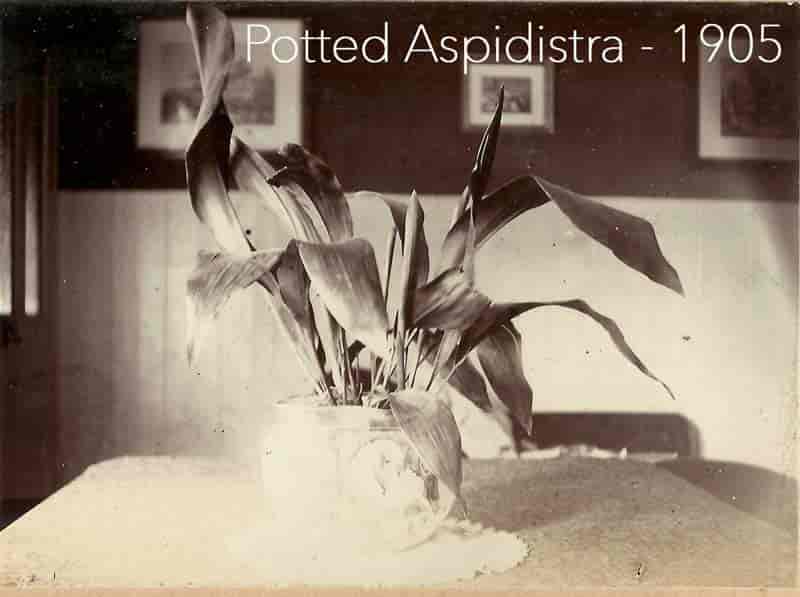
Full List Of Aspidistra Species
Below is a list of 169 Aspidistra species and varieties recognized by The World Checklist of Selected Plant Families at Kew as of September 10, 2017.
- Aspidistra (1823)
- Aspidistra acetabuliformis (1987)
- Aspidistra alata (2007)
- Aspidistra albiflora (2011)
- Aspidistra albopurpurea (2013)
- Aspidistra alternativa (2002)
- Aspidistra anomala (2016)
- Aspidistra arnautovii (2005)
- Aspidistra arnautovii var. angustifolia (2012)
- Aspidistra arnautovii var. arnautovii
- Aspidistra arnautovii var. catbaensis (2014)
- Aspidistra australis (2013)
- Aspidistra austrosinensis (1987)
- Aspidistra averyanovii (2016)
- Aspidistra bamaensis (2009)
- Aspidistra basalis (2012)
- Aspidistra bicolor (2005)
- Aspidistra bogneri (2005)
- Aspidistra brachystyla (2008)
- Aspidistra caespitosa (1939)
- Aspidistra campanulata (2007)
- Aspidistra carinata (1989)
- Aspidistra carnosa (2005)
- Aspidistra cavicola (1993)
- Aspidistra cerina (2002)
- Aspidistra chishuiensis (2010)
- Aspidistra chongzuoensis (2015)
- Aspidistra chunxiuensis (2015)
- Aspidistra clausa (2015)
- Aspidistra claviformis (1984)
- Aspidistra coccigera (2012)
- Aspidistra columellaris (2012)
- Aspidistra connata (2005)
- Aspidistra connata var. connata
- Aspidistra connata var. radiata (2014)
- Aspidistra crassifila (2013)
- Aspidistra cruciformis (1987)
- Aspidistra cryptantha (2007)
- Aspidistra cyathiflora (1989)
- Aspidistra cylindrica (2016)
- Aspidistra daibuensis (1920)
- Aspidistra daxinensis (2009)
- Aspidistra dodecandra (2005)
- Aspidistra dolichanthera (1982)
- Aspidistra ebianensis (1999)
- Aspidistra elatior (1834)
- Aspidistra elatior var. attenuata (2000)
- Aspidistra elatior var. elatior
- Aspidistra elatior var. vietnamensis (2012)
- Aspidistra elegans (2016)
- Aspidistra erecta (2011)
- Aspidistra erythrocephala (2016)
- Aspidistra fasciaria (1999)
- Aspidistra fenghuangensis (1999)
- Aspidistra fimbriata (1978)
- Aspidistra flaviflora (1982)
- Aspidistra foliosa (2005)
- Aspidistra fungilliformis (1984)
- Aspidistra fungilliformis subsp.formosa (2008)
- Aspidistra fungilliformis subsp. fungilliformis
- Aspidistra geastrum (2005)
- Aspidistra glandulosa (2005)
- Aspidistra globosa (2016)
- Aspidistra gracilis (2012)
- Aspidistra grandiflora (2007)
- Aspidistra guangxiensis (2003)
- Aspidistra guizhouensis (2015)
- Aspidistra hekouensis (1998)
- Aspidistra hezhouensis (2011)
- Aspidistra huanjiangensis (2003)
- Aspidistra jiewhoei (2013)
- Aspidistra jingxiensis (2012)
- Aspidistra khangii (2013)
- Aspidistra laotica (2014)
- Aspidistra lateralis (2005)
- Aspidistra leshanensis (1984)
- Aspidistra leyeensis (1987)
- Aspidistra liboensis (2011)
- Aspidistra linearifolia (1987)
- Aspidistra lingchuanensis (2015)
- Aspidistra lingyunensis (2013)
- Aspidistra lobata (2006)
- Aspidistra locii (2004)
- Aspidistra longanensis (1985)
- Aspidistra longgangensis (2015)
- Aspidistra longifolia (1892)
- Aspidistra longiloba (1988)
- Aspidistra longipedunculata (1982)
- Aspidistra longipetala (1986)
- Aspidistra longituba (2011)
- Aspidistra longshengensis (2015)
- Aspidistra lubae (2013)
- Aspidistra lubae var. lancifolia (2013)
- Aspidistra lubae var. lubae
- Aspidistra luodianensis (1992)
- Aspidistra lurida (1822)
- Aspidistra lutea (2005)
- Aspidistra marasmioides (2005)
- Aspidistra marginella (1993)
- Aspidistra minutiflora (1903)
- Aspidistra mirostigma (2014)
- Aspidistra molendinacea (2002)
- Aspidistra multiflora (2014)
- Aspidistra muricata (1981)
- Aspidistra mushaensis (1920)
- Aspidistra nanchuanensis (2006)
- Aspidistra nankunshanensis (2013)
- Aspidistra nikolaii (2008)
- Aspidistra obconica (2010)
- Aspidistra oblanceifolia (1982)
- Aspidistra obliquipeltata (2002)
- Aspidistra oblongifolia (1999)
- Aspidistra omeiensis (1981)
- Aspidistra opaca (2005)
- Aspidistra opaca var. opaca
- Aspidistra opaca var. rugosa (2014)
- Aspidistra ovatifolia (2014)
- Aspidistra oviflora (2014)
- Aspidistra papillata (2003)
- Aspidistra parviflora (2016)
- Aspidistra patentiloba (1989)
- Aspidistra paucitepala (2014)
- Aspidistra petiolata (2005)
- Aspidistra phanluongii (2012)
- Aspidistra pileata (2002)
- Aspidistra pingfaensis (2014)
- Aspidistra pingtangensis (2011)
- Aspidistra punctata (1826)
- Aspidistra punctatoides (2011)
- Aspidistra quadripartita (2002)
- Aspidistra recondita (2007)
- Aspidistra renatae (2005)
- Aspidistra retusa (1981)
- Aspidistra revoluta (2016)
- Aspidistra ronganensis (2016)
- Aspidistra saxicola (1984)
- Aspidistra semiaperta (2014)
- Aspidistra sichuanensis (1984)
- Aspidistra sinensis (2016)
- Aspidistra spinula (2002)
- Aspidistra stellata (2013)
- Aspidistra stenophylla (2014)
- Aspidistra stricta (2005)
- Aspidistra subrotata (1987)
- Aspidistra subrotata var. angustifolia (2010)
- Aspidistra subrotata var. crassinervis (2010)
- Aspidistra subrotata var. subrotata
- Aspidistra superba (2005)
- Aspidistra sutepensis (1961)
- Aspidistra tenuifolia (2014)
- Aspidistra tillichiana (2015)
- Aspidistra tonkinensis (1978)
- Aspidistra triloba (1981)
- Aspidistra triradiata (2015)
- Aspidistra truongii (2013)
- Aspidistra tubiflora (2006)
- Aspidistra typica (1894)
- Aspidistra umbrosa (2007)
- Aspidistra urceolata (1981)
- Aspidistra ventricosa (2014)
- Aspidistra wujiangensis (2015)
- Aspidistra xilinensis (1987)
- Aspidistra xuansonensis (2014)
- Aspidistra xuansonensis var. violiflora (2014)
- Aspidistra xuansonensis var. xuansonensis
- Aspidistra yizhouensis (2016)
- Aspidistra yunwuensis (2015)
- Aspidistra zinaidae (2012)
- Aspidistra zongbayi (1982)
Image: source
 Potted Aspidistra elatior with dark green foliage is a hardy plant. Used as a ground cover in the southern US. Does best when plants are not exposed to direct sunlight.
Potted Aspidistra elatior with dark green foliage is a hardy plant. Used as a ground cover in the southern US. Does best when plants are not exposed to direct sunlight. Keep the Aspidistra Flying by George Orwell. Penguin Edition, 1962.
Keep the Aspidistra Flying by George Orwell. Penguin Edition, 1962. 
 Bell-shaped flower of the cast iron plant – Aspidistra elatior via Stewart Black / Flickr
Bell-shaped flower of the cast iron plant – Aspidistra elatior via Stewart Black / Flickr

 Cast iron Aspidistra plants growing as a ground cover in a landscape bed – Disney World, Animal Kingdom 2018
Cast iron Aspidistra plants growing as a ground cover in a landscape bed – Disney World, Animal Kingdom 2018